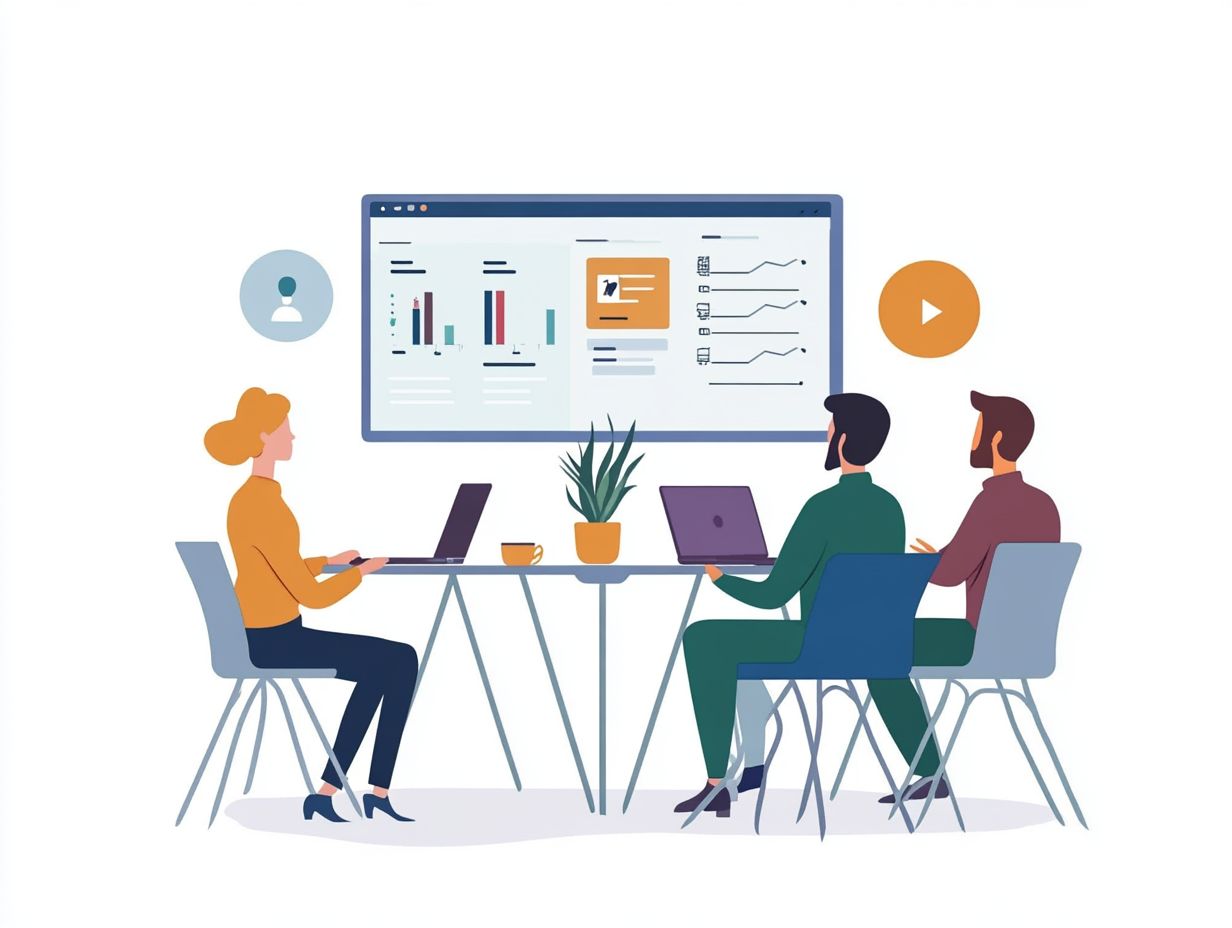E-Learning: Bridging Knowledge Gaps in Corporations
In today s fast-paced corporate landscape, e-learning is revolutionizing how you approach training and development.
This article delves into the different aspects of e-learning, illuminating its benefits, such as cost efficiency and flexibility, while also addressing the challenges you might face during implementation.
From navigating technological barriers to crafting engaging content, we ll share strategies for creating successful e-learning programs tailored to your needs.
We will also explore emerging trends that are poised to redefine the future of corporate learning.
Join us as we uncover how e-learning is effectively bridging knowledge gaps within organizations like yours.
Contents
- Key Takeaways:
- Benefits of E-Learning in Corporations
- Challenges of Implementing E-Learning
- Strategies for Successful E-Learning Programs
- The Future of E-Learning in Corporations
- Frequently Asked Questions
- What is E-Learning and how can it fill knowledge gaps in corporations?
- How can E-Learning be implemented in a corporate environment?
- What are the benefits of using E-Learning in corporations?
- What types of knowledge gaps can E-Learning help fill in corporations?
- Is E-Learning suitable for all types of employees?
- How can corporations ensure the effectiveness of E-Learning in filling knowledge gaps?
Key Takeaways:
Here are the essential points to remember:

- E-learning offers cost and time savings for corporations through its flexible and accessible nature.
- To implement successful e-learning programs, address technological barriers and overcome resistance to change.
- Designing engaging content and evaluating learning outcomes are crucial strategies for the success of e-learning in corporations.
What is E-Learning and How is it Used?
E-learning stands as a cornerstone of modern employee training, leveraging online learning tools to bridge knowledge gaps and promote ongoing learning among your workforce. This dynamic approach not only elevates the learning experience but also caters to various learning preferences, ensuring that knowledge is retained and effectively applied in real-world situations.
By offering customizable e-learning programs, you can address the unique needs of your employees, tailoring content to fit specific roles and skill sets. This strategy not only enhances engagement but also gives the power to employees to take control of their learning journeys, ultimately driving productivity to new heights.
The integration of data analysis enables you to track employee progress and pinpoint areas for improvement, leading to more effective training outcomes. With data-driven insights at your disposal, you can refine your e-learning strategies, ensuring that training remains relevant and impactful, equipping your team with the skills they need to thrive in an ever-evolving workplace.
Benefits of E-Learning in Corporations
Implementing e-learning in your corporation brings a wealth of benefits. You ll notice enhanced employee engagement, streamlined onboarding programs, and effective upskilling and reskilling initiatives that directly address any skills and knowledge gaps within your workforce.
These advantages empower your organization to adapt seamlessly to the rapidly evolving demands of the education sector and Industry 4.0.
Cost and Time Savings
Implementing e-learning can lead to substantial cost and time savings for your organization. By shifting away from traditional employee training methods, you can significantly reduce expenses and optimize the use of your resources. Leveraging online learning tools allows you to minimize training costs while maximizing the outcomes of your training initiatives.
One of the most impactful benefits is the elimination of travel expenses. Your employees no longer need to spend valuable company funds on transport or accommodations for off-site training sessions. Additionally, costs associated with printed materials plummet, as digital resources can be easily created, updated, and reused at a moment’s notice.
The introduction of just-in-time training further enhances time efficiency. Employees can access relevant information precisely when they need it, bypassing the delays of scheduled workshops. With a comprehensive content library at their fingertips, learners can revisit critical subjects at their convenience, ensuring they grasp essential concepts effectively while optimizing both learning time and organizational resources.
Flexibility and Accessibility
E-Learning offers unmatched flexibility and accessibility. You can engage with training content at your own pace and in a way that suits your learning style.
This personalized approach helps you balance your training with work responsibilities. Accessing learning materials from any location and device enhances convenience and continuity.
Whether you’re commuting or relaxing at home, dive into your courses whenever it suits you. This freedom fosters an engaged workforce and boosts productivity.
Organizations can create an effective and immersive learning environment. This ensures you and your colleagues are equipped with the latest skills needed to thrive.
Challenges of Implementing E-Learning

E-Learning has many advantages, but implementing it can be challenging. You may face technological barriers that hinder employee engagement and resistance to change among staff.
Addressing these hurdles is essential for successfully adopting E-Learning initiatives.
Addressing Technological Barriers
Overcoming technological barriers is essential for successful E-Learning. Inadequate infrastructure can limit access to digital learning technologies.
Your organization must invest in tools for integration, such as software that connects different systems, and analytics to enhance the learning experience.
Upgrade internet connectivity and ensure employees have access to the latest software and tools. Regular assessments of current technologies help identify gaps needing attention.
Leveraging analytics provides insights into employee engagement and performance. Continuously monitoring training outcomes through methods that use data allows you to tailor programs to individual learning needs.
Overcoming Resistance to Change
Overcoming resistance to change is vital for adopting E-Learning programs. Employees accustomed to traditional training methods may hesitate.
Engage your team in the learning process and highlight the benefits of E-Learning. Involving people with specialized knowledge can enhance content quality and encourage employee buy-in.
As a leader, foster a culture of continuous learning with open communication and constructive feedback. Create spaces for employees to voice their concerns about new learning methods.
Showcase success stories from peers to motivate others. This shift is not just a trend; it leads to meaningful personal and professional growth.
Strategies for Successful E-Learning Programs
Successful E-Learning programs require well-defined strategies. Focus on effective instructional design, captivating content, and robust performance metrics.
Implementing these strategies can elevate the learning experience and help achieve your training goals. Start your E-Learning journey today and transform your skills!
Effective Content Design
Designing engaging and effective content is essential for your E-Learning programs. It captivates learners and enhances their knowledge retention. By using instructional design principles and incorporating diverse formats like experiential learning and video content, you can significantly elevate the overall learning experience.
Utilizing various instructional design models, such as ADDIE or SAM, allows you to structure your content more effectively. This ensures it aligns with your specific learning goals. Integrating multimedia elements like interactive simulations, infographics, and podcasts offers a richer, more immersive experience that caters to different learning styles.
Peer-to-peer learning boosts collaboration. It also deepens understanding. Incorporating real-world applications helps learners grasp the relevance of their training. By emphasizing these best practices, you not only boost engagement but also ensure that your training material meets the diverse needs of today s learners.
Measuring and Evaluating Learning Outcomes

Measuring and evaluating learning outcomes is crucial for your E-Learning programs. It provides valuable insights into training effectiveness and learner engagement. By using performance metrics and analytics reports, you can continuously refine your training strategies for better results.
Assessments like quizzes and practical assignments give you a clear gauge of learner comprehension and retention. Feedback from participants shows where improvements are needed and offers rich qualitative data.
These methods provide a clear view of each learner’s journey. Analyzing this data allows you to identify trends and patterns. It gives you the power to make informed decisions that will enhance future E-Learning initiatives.
By concentrating on evidence-based insights, you can adapt your approaches to meet the evolving needs of learners and optimize the overall educational experience.
The Future of E-Learning in Corporations
The future of E-Learning in corporations is set for an exciting transformation. It is fueled by emerging technologies that significantly elevate corporate learning and workforce development.
Innovations like augmented reality, virtual reality, and AI-driven personalized learning are ready to reshape the very landscape of employee training, creating experiences that are more engaging and effective.
Emerging Technologies and Trends
Emerging technologies and trends are transforming the E-Learning landscape. Tools like augmented reality and virtual reality offer immersive training experiences that engage you in unique ways. These innovations enhance how content is delivered and cater to your diverse learning preferences.
The integration of artificial intelligence paves the way for personalized learning pathways. It allows training modules to be tailored specifically to your needs and skill levels. This customization gives you the power to progress at your own pace, leading to a deeper understanding of the material.
Collaborative learning platforms are also on the rise. They encourage you and your colleagues to come together in virtual environments, share insights, and tackle problems as a team.
With these advancements, companies are streamlining employee training and significantly boosting overall engagement. This transforms learning into a more interactive and communal experience.
Potential Impact on Corporate Learning and Development
The potential impact of E-Learning on corporate learning and development is nothing short of transformative. It gives you the power to swiftly adapt to the ever-changing skills required in today s workforce while nurturing a culture of innovation.
By embracing E-Learning strategies, you can better cater to employee needs and elevate overall service quality. This approach tackles existing skills gaps and fosters a culture of continuous learning, aligning your professional development with broader organizational objectives.
As you engage with customized training programs, you ll find yourself upskill more efficiently and feel a greater sense of investment in your career trajectory.
By incorporating E-Learning into your training initiatives, you ensure that your workforce remains agile and competitive, ultimately enhancing performance and driving strategic goals forward. The seamless integration of technology and training creates a dynamic learning environment that adapts to the ever-evolving business landscape.
Frequently Asked Questions
Below are some common questions regarding E-Learning in corporate environments:
What is E-Learning and how can it fill knowledge gaps in corporations?

E-Learning refers to the use of electronic technologies to deliver educational content and training programs to individuals. It is a convenient and efficient method for employees to acquire new knowledge and skills, filling any gaps in their current knowledge base.
By providing access to a wide range of online resources, E-Learning can help corporations fill gaps in their employees’ knowledge and improve overall performance, as outlined in the future of e-learning in corporate training.
How can E-Learning be implemented in a corporate environment?
E-Learning can be implemented in various ways, such as through online courses, virtual classrooms, webinars, and interactive videos. Some companies also use software to organize and track employee training.
E-Learning can be integrated into existing employee training programs or used as a standalone method for knowledge acquisition.
What are the benefits of using E-Learning in corporations?
- Cost-effectiveness
- Flexibility
- Accessibility
E-Learning allows employees to learn at their own pace and on their own time, reducing the need for in-person training sessions. It also ensures consistency in training material and allows for easy updates as industries and technologies evolve.
What types of knowledge gaps can E-Learning help fill in corporations?
E-Learning can help bridge both technical and soft skill gaps in corporations. It provides employees with the latest information and training in their specific industry or field, as well as improves their communication, time management, and leadership skills. However, there are also significant challenges of e-learning in corporate settings that organizations need to consider.
E-Learning can also bridge intergenerational gaps by leveraging e-learning for employee performance, providing a common platform for learning and development for employees of all ages.
Is E-Learning suitable for all types of employees?
Yes, E-Learning can be tailored to meet the specific needs and learning styles of different employees. It includes various multimedia elements, such as videos, audio recordings, interactive quizzes, and simulations, to engage different types of learners.
E-Learning can also be adapted for employees with disabilities, making it a versatile option for all employees.
How can corporations ensure the effectiveness of E-Learning in filling knowledge gaps?
To ensure the effectiveness of E-Learning, corporations should regularly assess and update their training materials to keep up with industry changes and employee feedback.
It is also important to provide support and resources for employees to access and utilize the E-Learning programs effectively. Regular evaluations and feedback from employees can help improve the E-Learning experience and bridge any remaining knowledge gaps.






